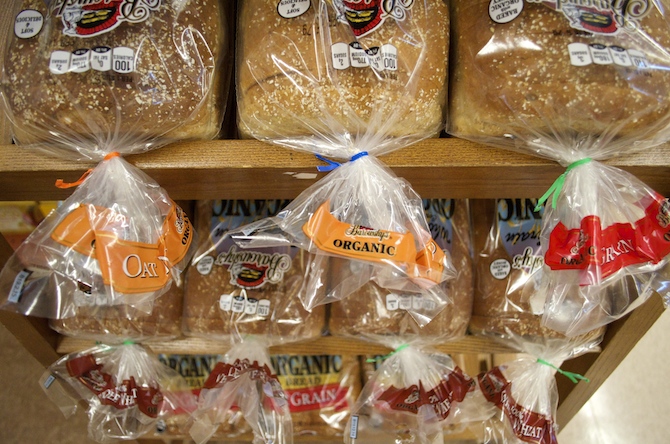
Yup, these little twist ties are color coded to designate which day of the week the bread was baked. The code is meant to do a service to employees stocking shelves, but shoppers should take advantage of the secret system, too. No more squeezing loaves of bread or checking the “sell by” date to assess freshness; these ties make finding your prized fresh bread easier.

Gif courtesy of giphy.com
The standard code is as follows:
Blue: Monday
Green: Tuesday
Red: Thursday
White: Friday
Yellow: Saturday
To remember this color key just think of the alphabet; the earlier the colors occur in the alphabet, the earlier the bread was baked.

Photo by Anthony Nomakeo
This discovery also applies to plastic closures which have become more widely used by companies. (These closures were probably designed for bungling twist tie openers like me.) The special colors of these fasteners match with the code above.
Exceptions
Unfortunately there are some special cases when it comes to this color system. Rarely, but sometimes you might find ties or plastic closures that are all one color, despite the day the loaves were baked.

Photo by Anthony Nomakeo
In those situations you should check the “sell by” date. Just remember that “sell by” dates aren’t always accurate; if you store your bread in the refrigerator it can last up to two weeks. If you stick it in the freezer, we’re talking six months of edibility.
Also, though the code above is considered universal, some companies in the industry have their own cipher. If you’re very sweet on a certain brand of bread, you should call the company and request their code.
So peace out hard, overstored bread! We won’t be seeing you soon.
Learn more about shopping for and eating bread with these articles:
- How Long Will My Food Stay Fresh?
- Which Bread To Buy: Whole Grain or Whole Wheat?
- When To Eat Moldy Food
Us carbaholics need our leavened doses pronto. But to unseal a new loaf of bread you have to deal with uncoiling that lousy twist tie. For me, this is a long process which involves twisting the tie the wrong way… multiple times.

Gif courtesy of giphy.com
So when it comes to resealing the package, I spin the plastic wrap into a synthetic dreadlock and throw that pesky tie in the trash.
It’s a small strip of synthetic material, for crying out loud. WE JUST CARE ABOUT THE BREAD. Well, folks, the truth? You should actually consider these teasing little ties if you want your bread to be ultra fresh.

Yup, these little twist ties are color coded to designate which day of the week the bread was baked. The code is meant to do a service to employees stocking shelves, but shoppers should take advantage of the secret system, too. No more squeezing loaves of bread or checking the “sell by” date to assess freshness; these ties make finding your prized fresh bread easier.

Gif courtesy of giphy.com
The standard code is as follows:
Blue: Monday
Green: Tuesday
Red: Thursday
White: Friday
Yellow: Saturday
To remember this color key just think of the alphabet; the earlier the colors occur in the alphabet, the earlier the bread was baked.

Photo by Anthony Nomakeo
This discovery also applies to plastic closures which have become more widely used by companies. (These closures were probably designed for bungling twist tie openers like me.) The special colors of these fasteners match with the code above.
Exceptions
Unfortunately there are some special cases when it comes to this color system. Rarely, but sometimes you might find ties or plastic closures that are all one color, despite the day the loaves were baked.

Photo by Anthony Nomakeo
In those situations you should check the “sell by” date. Just remember that “sell by” dates aren’t always accurate; if you store your bread in the refrigerator it can last up to two weeks. If you stick it in the freezer, we’re talking six months of edibility.
Also, though the code above is considered universal, some companies in the industry have their own cipher. If you’re very sweet on a certain brand of bread, you should call the company and request their code.
So peace out hard, overstored bread! We won’t be seeing you soon.


